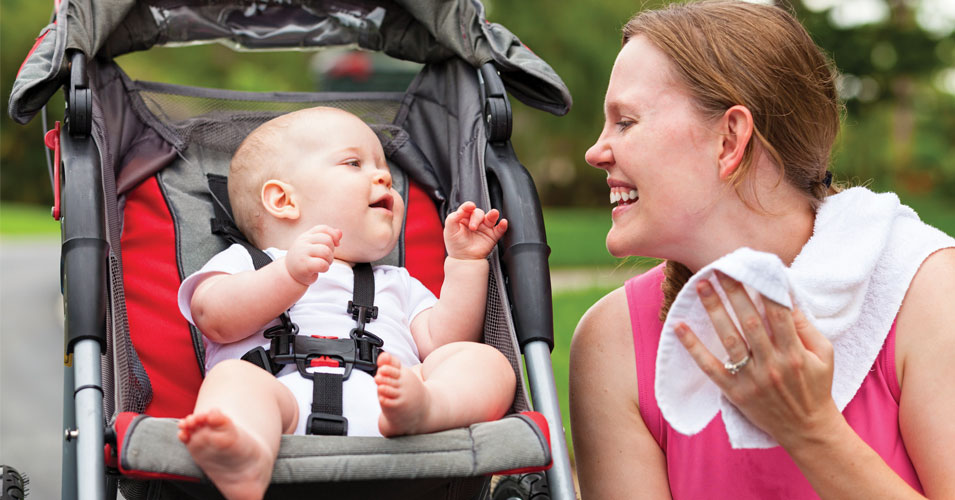Motherhood is a blissful time of getting to know your new baby, and a not-so-blissful time of coming to terms with your new body. Fortunately, in recent years it’s grown easier for women to find support for feeling good about their bodies in the moment, instead of at some distant point in the future. Here are five trends you can start leveraging today on your path to postpartum fitness.
1. Get body positive
Perfect is passé! Plus-sized models have become mainstream, major brands have launched “natural beauty” campaigns, and women have rallied together to embrace the physical changes that come with motherhood. Google the phrase “tiger stripe moms” and see images of mothers showing off their stretch marks as a badge of honor instead of as a source of embarrassment.
Body positivity is about feeling good in your own skin, on your terms—less about being the “right size” than about being in the right mindset.
Starting today: Stop using numbers to define your fitness. Instead of targeting a certain weight or counting calories, set a goal that’s defined by how you want to feel.
Read: “Weighing In: Can we unpack our body-image baggage?”
2. Do shorter workouts
In today’s time-crunched world, everyone struggles to get a workout in—which is why the fitness industry has revamped its ways as we seek to balance our body goals along with professional, social and family obligations.
High-intensity interval training (HIIT)—think Beachbody, Insanity and P90X —is designed to provide an effective workout over a shorter period. If high intensity isn’t for you, try sprinkling in a series of moderate-intensity efforts across your day. For example, six 10-minute sessions instead of one hour-long session.
The Department of Health and Human Services has established adult exercise guidelines to be a minimum of 150 minutes of moderate aerobic activity each week, such as a power walk or a light jog. That’s 21 minutes per day.
Starting today: Take your baby for a walk. If you’re pushing a stroller, up the pace to a run for higher intensity, or stop at intervals to add impact moves like jumping jacks or burpees. If you’re wearing your baby, walk at a brisk pace and add in walking lunges.
3. Try a wearable
Wearables (like FitBit) have changed the way we measure fitness. Completing 10,000 steps per day is the new baseline workout, and not a single step requires a running shoe!
I was skeptical of FitBit at first. Coming from an endurance training background, I wasn’t sure that counting steps over the course of my day could provide an effective workout, but now I’m a believer. I was easily able to reach 10,000 steps per day while doing regular housework and running errands. Rather than be annoyed at an extra trip to the basement for a forgotten laundry basket, or frustrated when the closer parking spots were taken at the store, I started to see these “inconveniences” as opportunities to get more steps.
The result? Instant gratification that I was actively meeting my fitness goals and a feeling of pride that I could multitask my regular day into a workout.
Starting today: Look for ways to extend or enhance the movement that’s already built into your day. Take the stairs instead of the elevator, or balance on one leg while loading the dishwasher. You don’t need a fitness tracker to realize that the extra steps and effort will add up!
4. Start social networking
Working out with a partner is an effective way to stay focused on your goals, but it’s not always easy to align our busy schedules with other people. Social media has made it so we no longer need to be with people in real time to experience the benefits of camaraderie. We don’t even have to live in the same state!
For example, Facebook groups like Women For Tri connect women from all over the world who are new to triathlon, offering a platform for them to share advice and support. Even if you live in a remote area, you can feel a sense of support while working out in your living room.
Starting today: Find a group online to share your goals with, and use it as a sounding board for the positive and negative experiences along the way.
5. Be mindful
Fitness isn’t limited to physical attributes: It’s about taking care of mental health, too. Body and mind must be balanced for overall wellness. Yoga is a great way to cover all the bases, but being mindful shouldn’t always be tied to a workout. Taking a break in your fitness routine actually helps you stay on track over the long term.
Starting today: Schedule a non-fitness activity for yourself, such as a nail appointment, a movie at the theater, or some quiet time with a coloring book.





